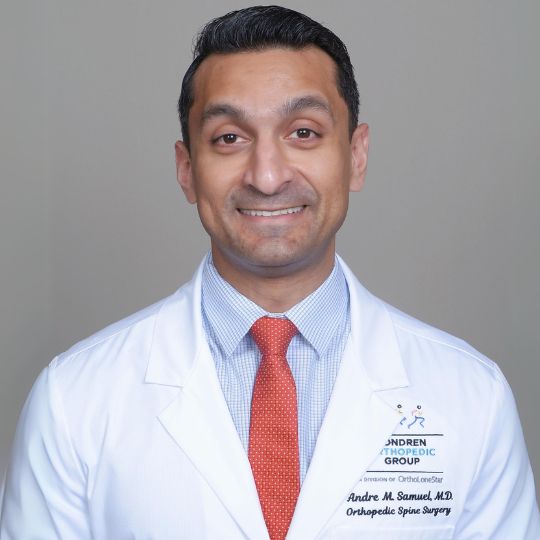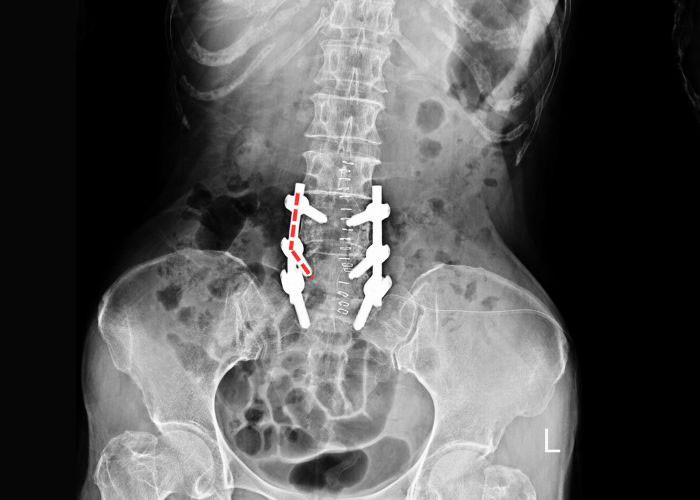Failed Spinal Hardware Specialist
If you’ve been diagnosed or believe you have a loose screw or a broken rod following spinal surgery, it’s crucial to seek expert medical intervention to address these complications. Dr. Andre M. Samuel, a top spinal specialist based in the Clear Lake, Houston, and Sugar Land areas, offers comprehensive care for the treatment of failed hardware, loose spinal screws, or broken rods. Contact Dr. Samuel’s office for an appointment today!

What is spinal hardware failure?
A hardware failure generally refers to problems with any medical device implanted to provide structural support and stability. In this case, the term refers to hardware used in spinal surgeries like screws, rods, and plates. These devices are intended to help strengthen and stabilize the spine after procedures such as a spinal fusion, but sometimes they do fail for a variety of reasons such as a loose spinal screw or a broken rod. When failed hardware occurs, it often results in symptoms such as increased back pain, instability, and impaired mobility. Doctor Andre M. Samuel, orthopedic spine specialist, treats patients in the Clear Lake, Houston, Sugar Land, TX area suffering from failed hardware, loose spinal screws, or broken rods.

What are the common causes of failed hardware?
Some common causes of failed hardware include but are not limited to:
- Loosening of screws or rods – Over time, the screws or rods implanted during surgery may become loose. This usually only occurs if the underlying bony fusion has not properly healed, or if the patient has a traumatic injury.
- Rod or screw fracture – The metal hardware can break under the stress of supporting the spinal column. This usually only occurs if the underlying bony fusion has not properly healed, or if the patient has a traumatic injury.
- Displacement – Components of the hardware might move from their original positions, affecting the spine’s stability.
- Infection: Though not a failure of the hardware itself, infection around the implanted device can lead to complications requiring removal or replacement of the hardware.
Some patients may develop pain around or an allergic reaction to the metal used in the hardware. In this case, the parts may also need to be removed or replaced.
Who is more susceptible to failed hardware?
Certain patients are more susceptible to failed hardware after spinal surgeries than others. Those with osteoporosis may not securely hold surgical hardware, leading to potential issues like a loose spinal screw. Additionally, overweight patients and those who exert extra pressure on the spine have an increased risk of a broken rod or screw. Smokers and patients with chronic conditions like diabetes face impaired bone healing, further compromising hardware stability. Previous spinal surgeries can also weaken structures necessary for supporting new hardware.
What are the first signs or symptoms of broken hardware in the back or neck ?
The signs and symptoms of failed spinal hardware i.e. a loose screw or a broken rod, can vary from patient to patient. The most common signs and symptoms may include:
- Increased pain after a period of improvement.
- New or worsening difficulty moving, bending, or twisting.
- Popping, clicking, or grinding noises coming from the spine area during movement.
- Any visible bulging or changes in the shape of the back or spine, especially near the surgical site.
- New or increased pain, numbness, or weakness in the limbs
Swelling, warmth, or redness at the surgical site, particularly when accompanied by a fever, can indicate an infection. This is a serious condition that requires prompt medical attention.
How is failed hardware diagnosed?
Dr. Samuel will perform a thorough physical exam, checking for tenderness, pain, and abnormal movements that might suggest failed hardware. He will order a series of X-rays to check the alignment of the spine and see if there are any loose or broken screws and/or rods. If X-rays are inconclusive, a CT scan or an MRI may provide clearer images of the bone, the hardware, and the surrounding soft tissues. Bone scans and other nerve studies may also be needed to rule out other causes of the pain.
What is the treatment for failed hardware?
Treatment options for spinal hardware failure is very complex, and requires a personalized treatment plan depending on each patients symptoms, overall health, and type of hardware. Dr. Samuel advises conservative treatments when symptoms are mild and do not threaten spinal stability or nerve function. Such approaches may include pain management using over-the-counter pain relievers like NSAIDs, or prescription drugs such as muscle relaxants or nerve pain medications. Additionally, corticosteroid injections can help reduce inflammation and alleviate pain. Nerve blocks may also be used to provide temporary relief.
Physical therapy is often prescribed to strengthen the muscles surrounding the spine, which helps reduce pain and improve function. Dr. Samuel tailors the treatment plan to suit each patient’s needs while minimizing the risks associated with more invasive procedures.
If conservative treatments fail to provide relief or if there is significant pain, instability, or neurological symptoms due to the failed hardware, Dr. Samuel will recommend hardware revision surgery. There are several different options available including:
Surgical options:
- Removal of the failed hardware – This is done if the hardware is no longer needed to support the spine.
- Replacement or Additional Hardware – New or extra hardware may be needed to support and realign the spine.
- Spinal Fusion – A new graft or different hardware may be needed to fuse two vertebrae.
- Decompression Surgery – A procedure to relieve nerve compression caused by a loose spinal screw or broken rod.
Dr. Samuel has extensive experience working with a wide variety of historical and current spinal hardware systems in revision setting for removal, modification, or replacement when necessary. Dr. Samuel and his team work with each patient to choose the most appropriate and safest treatment.



